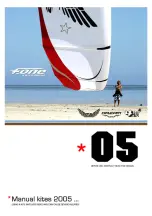
23
WARNING: Be sure to perform any
simulated collapses correctly. In
particular, full speed asymmetric
collapses performed incorrectly
may result in unpredictable collapse
behaviour and impulsive re-opening.
This behaviour may require considerable
pilot skill to manage safely.
WARNING: uncoordinated wingovers can
result in large asymmetric collapses or
cravattes. Always make sure you have
sufficient ground clearance and the
necessary skill and experience before
attempting such manoeuvres.
TIP: Make sure your wing is overhead
at the start of your tow. Be careful not
to over-control the wing as it reacts
differently to control inputs when on
tow.
you have the necessary skill, training and experience to perform this manoeuvre safely.
Rear riser steering
If, for any reason, you are unable to use the brakes to steer the glider, you can also use the
rear risers. Take care to use only small inputs. Pulling the rear risers too hard may cause a stall.
Flying with a wet paraglider
Never fly with a wet paraglider or in the rain. Doing so increases the risk of a deep (parachutal)
stall. If you do get caught out, never use big ears. Fly with the minimum of brake and head for the
landing immediately. Apply moderate speed bar for an additional safety margin.
Deep stall
A deep (parachutal) stall is only likely to occur in exceptional circumstances, such as if the
glider is flown when wet, if the lines are significantly out-of-trim or if the glider is flown in
extreme turbulence.
In a deep stall, the canopy may be open, but is descending vertically with little or no forward
speed.
To exit a deep stall, fully release both brakes and allow the glider to return to normal flight. If
the glider remains in the deep stall, put your hands on the A-risers and push forwards, or apply
your speed bar.
Содержание Yeti-4
Страница 1: ......
Страница 2: ...pilot manual v1 0 30 11 2015 ...
Страница 3: ...Photo Jerome Maupoint ...
Страница 35: ...35 Brake line knot diagram ...
Страница 36: ...36 Diagram of parts Top view Front view Side view ...















































